Catholic Virtues
 |
 |
 |
 |
 |
 |
 |
True & False Paths to Happiness - XXX
Certain Aspects of Reality Are
Best Expressed by Art
In the last article we looked at transcendence as applied to the absolute of good. Transcendence can also apply to the terrain of evil.
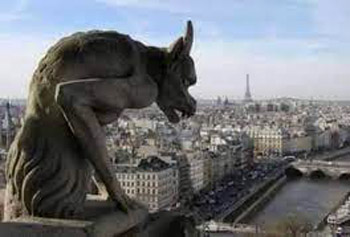 I recall one of those horned demons on Notre-Dame Cathedral, somewhat asthmatic, looking out with a breath of hatred at the city of Paris. It is only a concrete entity, but it expresses something universal. All the envy, all the hatred of all time find an expression there.
I recall one of those horned demons on Notre-Dame Cathedral, somewhat asthmatic, looking out with a breath of hatred at the city of Paris. It is only a concrete entity, but it expresses something universal. All the envy, all the hatred of all time find an expression there.
The categorical rejection of this diabolical hatred, which also manifests itself in human actions throughout History, certainly moves us toward God.
Relativism, the opposite of transcendence
The opposite of transcendence is relativism. For one affected by this disease, the eternal, absolute, evident and immutable truth does not exist. Nor does he want it to exist.
The relativist only has impressions. He calls these impressions convictions when they are very old or when they have held by a few generations and no one has doubted them before him. But they are not true convictions.
In this book called the Universe, he reads nothing. The Prophet Isaiah seems to be referring to him when he says: "Be astonished and wander, waver and stagger: be drunk and not with wine: stagger and not with drunkenness.” (Is 29: 9). In everything, the relativist sees only banality, which is a form of sleep.
Is there objectivity in transcendence?
A relativist will ask: "What is this labor for the sake of transcendence? Is it not a waste of time? Is it not a lack of objectivity? Is it not better to always see reality naked and raw, in its pure simplicity?"
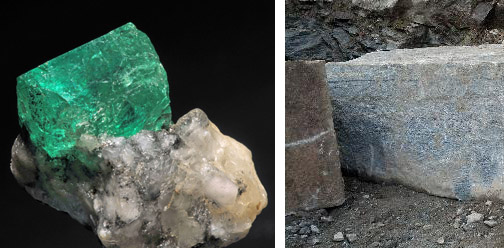 However, if there is indeed an underlying meaning to things, failing to see it would be to impoverish oneself and flee from reality.
However, if there is indeed an underlying meaning to things, failing to see it would be to impoverish oneself and flee from reality.
The relativist's questions lead to another, which I have asked myself since childhood: Is a block of granite always just quartz, feldspar and plagiociase, or can it have some deeper meaning? Is an emerald just the mineral beryl colored green by trace amounts of chromium and vandium, as my chemistry professor told me, or is it something else?
The search to see something transcendent in everything would lack objectivity if that something were not part of the reality.
Now then, transparency points to something that, in one way or another, is actually in the thing, due to the mechanism already described with regard to participation.
Photos can transcend also
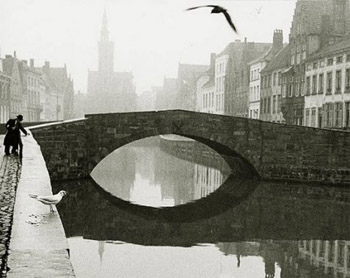 Now then, one might say that he who wants to see reality naked and raw, simplistic and stripped of any other considerations would prefer photography to painting. For, in photos, reality is portrayed by a mere mechanism without the interference of the fantasy of man.
Now then, one might say that he who wants to see reality naked and raw, simplistic and stripped of any other considerations would prefer photography to painting. For, in photos, reality is portrayed by a mere mechanism without the interference of the fantasy of man.
But is it true that even in the photos there is nothing else? Modern photographic art often seeks to imply something that transcends reality. The most excellent photos usually imply a transparency.
The photograph of a simple banal bridge such as, for example, the one the great photographer Fulvio Roiter includes in his album on Venice above left, is eloquent in this sense.
In the photo below, we see that the photographer was able to communicate a message with the click of his camera button. He knew how to note a certain transparency in the clouds over the Palace of Versailles.
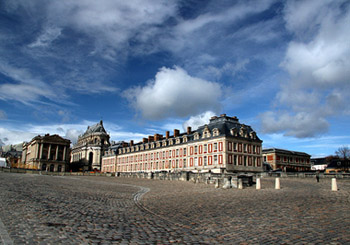
Above the castle is the cloud-filled sky: The photographer caught these clouds at a very happy moment. They were evidently not placed there by Louis XIV... They are at the exactly right place, with the precise configuration needed, to adorn the photograph.
Imagine the sky without these clouds: a blue, blue sky... A superficial person would think that the more blue, the more beautiful.
But, no, not here. The clouds compensate for a certain mystery lacking in the Castle de Versailles. One can see that they are in motion and they are fading and darkening at the same time. One has the impression that there is something rising, increasing, insinuating the beginning of a drama unfolding over the laughing castle and the blue sky.
One could almost say that they are the first signs of the French Revolution mixed with the last glories of the Monarchy. The clouds are there in the exact amount and place, with the right size, to adorn the picture.
All that is big, if it does not have something of the heroic or tragic, loses its greatness. The Chateau de Versailles at times lacks this tragic note, this heroic note, this mysterious note; the clouds in the picture compensate perfectly.
In this photo, there is no artifice to represent reality as it is not. But it is also not a literally realistic image, because it captured reality with some unreal notes.
Certain aspects of reality are best expressed by art
The significance of a thing, when it is noteworthy, comes from the light of the thing. This light is perceived either in a purely analytical way (that is, by a rational analysis of what it is) or in a symbolic way.
A rational analysis is made through words. Now then, it is a generally admitted fact that literature and art are intended to serve man as a means of expressing certain things which, by mere words, a man is unable to explain with fidelity.
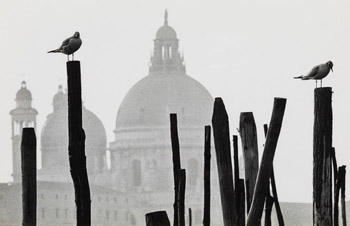 This fact sometimes draws a derogatory and unacceptable conclusion regarding philosophy: it would be an explicit and secondary field. Art and poetry would express something superior that philosophy could not do.
This fact sometimes draws a derogatory and unacceptable conclusion regarding philosophy: it would be an explicit and secondary field. Art and poetry would express something superior that philosophy could not do.
It is true that human words are not capable of adequately expressing certain aspects of reality. They come to the knowledge of man in a non-abstract way and at times belong to an order so high that they even surpass the force of expression of the word.
Establishing a reversibility between art and philosophy, man would feel what is most profound in a thing expressed. Thus, he could turn what he perceived through the artistic path into expressed terms. And, in the opposite sense, he could find in the artistic path a simile of what he sees in expressed terms.
In the world of thought, from the moment when the man would habitually try to express the inexpressible, an intercommunication between the two domains would open, from which a new era could be born.
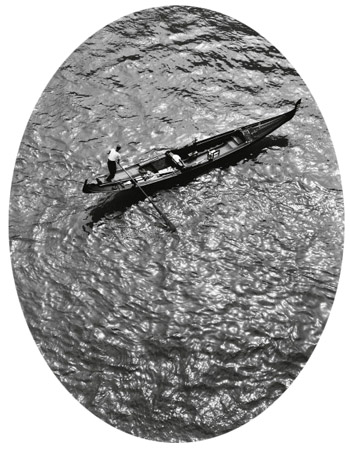
Continued


A gargoyle looms menacingly atop Notre Dame
The categorical rejection of this diabolical hatred, which also manifests itself in human actions throughout History, certainly moves us toward God.
Relativism, the opposite of transcendence
The opposite of transcendence is relativism. For one affected by this disease, the eternal, absolute, evident and immutable truth does not exist. Nor does he want it to exist.
The relativist only has impressions. He calls these impressions convictions when they are very old or when they have held by a few generations and no one has doubted them before him. But they are not true convictions.
In this book called the Universe, he reads nothing. The Prophet Isaiah seems to be referring to him when he says: "Be astonished and wander, waver and stagger: be drunk and not with wine: stagger and not with drunkenness.” (Is 29: 9). In everything, the relativist sees only banality, which is a form of sleep.
Is there objectivity in transcendence?
A relativist will ask: "What is this labor for the sake of transcendence? Is it not a waste of time? Is it not a lack of objectivity? Is it not better to always see reality naked and raw, in its pure simplicity?"

Raw emerald & quartz; right, a block of granit.
Below, the Duchess d’Angouleme's emerald tiara
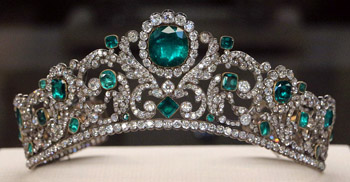
The relativist's questions lead to another, which I have asked myself since childhood: Is a block of granite always just quartz, feldspar and plagiociase, or can it have some deeper meaning? Is an emerald just the mineral beryl colored green by trace amounts of chromium and vandium, as my chemistry professor told me, or is it something else?
The search to see something transcendent in everything would lack objectivity if that something were not part of the reality.
Now then, transparency points to something that, in one way or another, is actually in the thing, due to the mechanism already described with regard to participation.
Photos can transcend also

Fulvio's simple bridge sends a symbolic message
But is it true that even in the photos there is nothing else? Modern photographic art often seeks to imply something that transcends reality. The most excellent photos usually imply a transparency.
The photograph of a simple banal bridge such as, for example, the one the great photographer Fulvio Roiter includes in his album on Venice above left, is eloquent in this sense.
In the photo below, we see that the photographer was able to communicate a message with the click of his camera button. He knew how to note a certain transparency in the clouds over the Palace of Versailles.

Above the castle is the cloud-filled sky: The photographer caught these clouds at a very happy moment. They were evidently not placed there by Louis XIV... They are at the exactly right place, with the precise configuration needed, to adorn the photograph.
Imagine the sky without these clouds: a blue, blue sky... A superficial person would think that the more blue, the more beautiful.
But, no, not here. The clouds compensate for a certain mystery lacking in the Castle de Versailles. One can see that they are in motion and they are fading and darkening at the same time. One has the impression that there is something rising, increasing, insinuating the beginning of a drama unfolding over the laughing castle and the blue sky.
One could almost say that they are the first signs of the French Revolution mixed with the last glories of the Monarchy. The clouds are there in the exact amount and place, with the right size, to adorn the picture.
All that is big, if it does not have something of the heroic or tragic, loses its greatness. The Chateau de Versailles at times lacks this tragic note, this heroic note, this mysterious note; the clouds in the picture compensate perfectly.
In this photo, there is no artifice to represent reality as it is not. But it is also not a literally realistic image, because it captured reality with some unreal notes.
Certain aspects of reality are best expressed by art
The significance of a thing, when it is noteworthy, comes from the light of the thing. This light is perceived either in a purely analytical way (that is, by a rational analysis of what it is) or in a symbolic way.
A rational analysis is made through words. Now then, it is a generally admitted fact that literature and art are intended to serve man as a means of expressing certain things which, by mere words, a man is unable to explain with fidelity.

Another expressive photo by Fulvio Roiter
It is true that human words are not capable of adequately expressing certain aspects of reality. They come to the knowledge of man in a non-abstract way and at times belong to an order so high that they even surpass the force of expression of the word.
Establishing a reversibility between art and philosophy, man would feel what is most profound in a thing expressed. Thus, he could turn what he perceived through the artistic path into expressed terms. And, in the opposite sense, he could find in the artistic path a simile of what he sees in expressed terms.
In the world of thought, from the moment when the man would habitually try to express the inexpressible, an intercommunication between the two domains would open, from which a new era could be born.

Continued

Posted July 2, 2021





